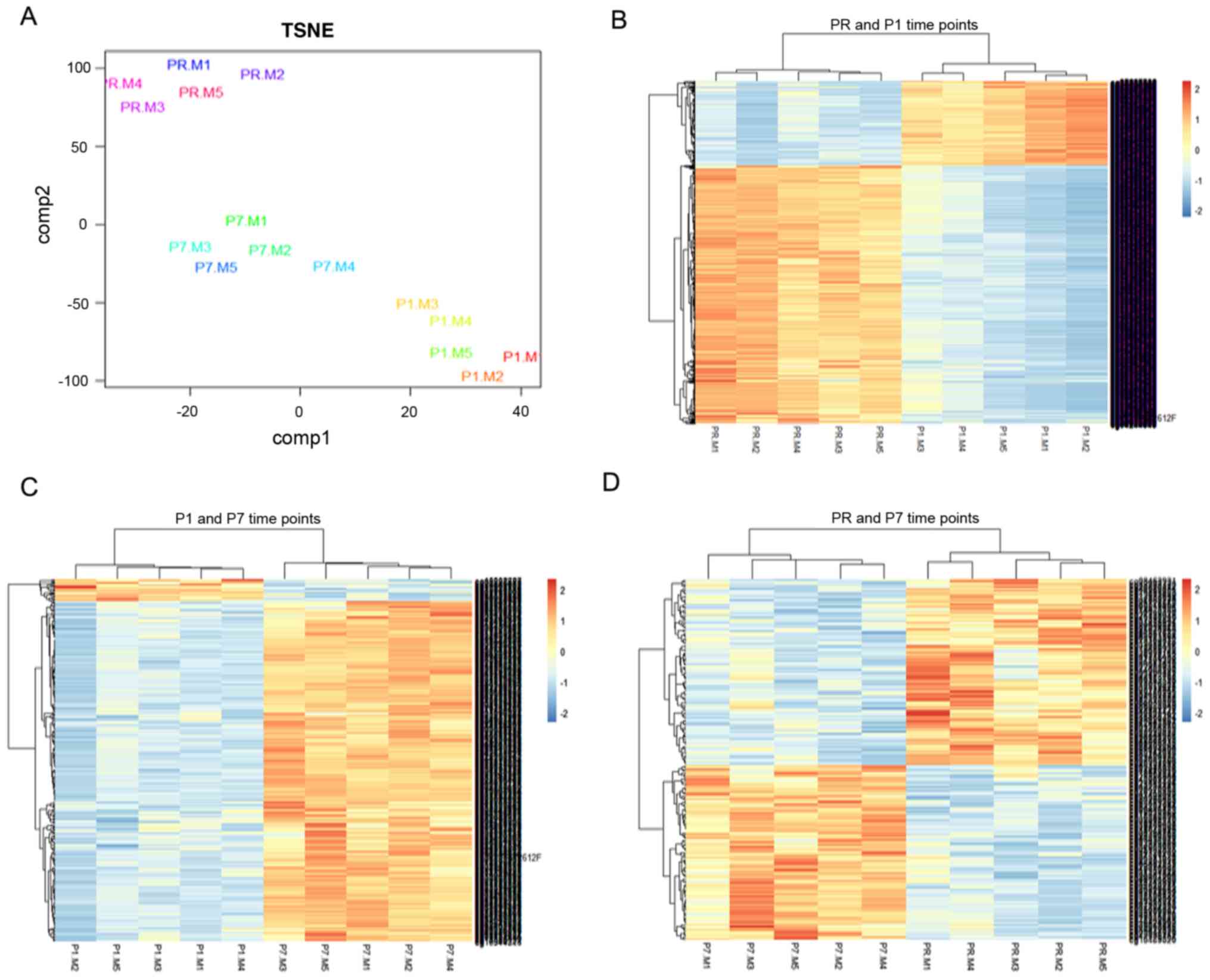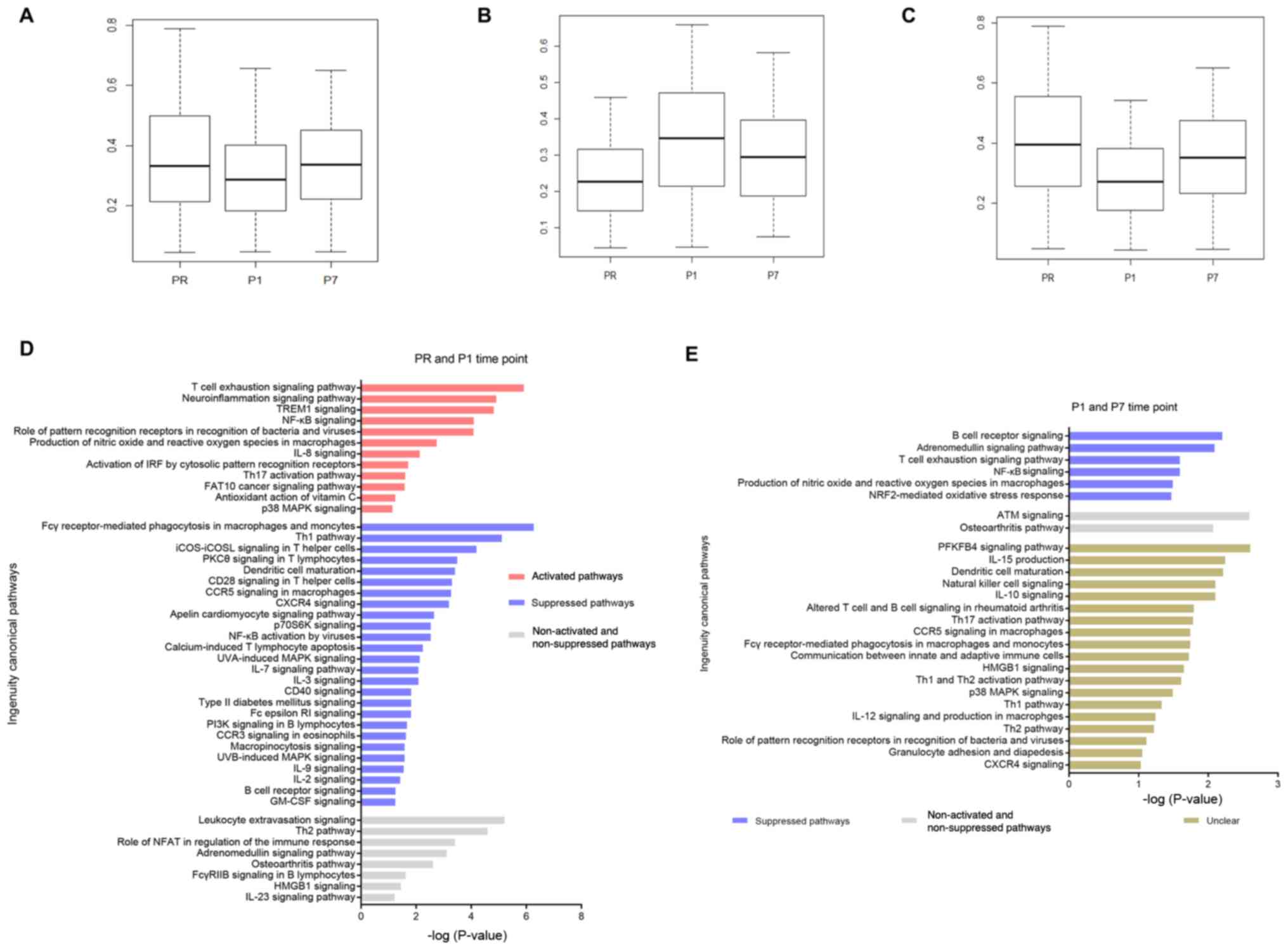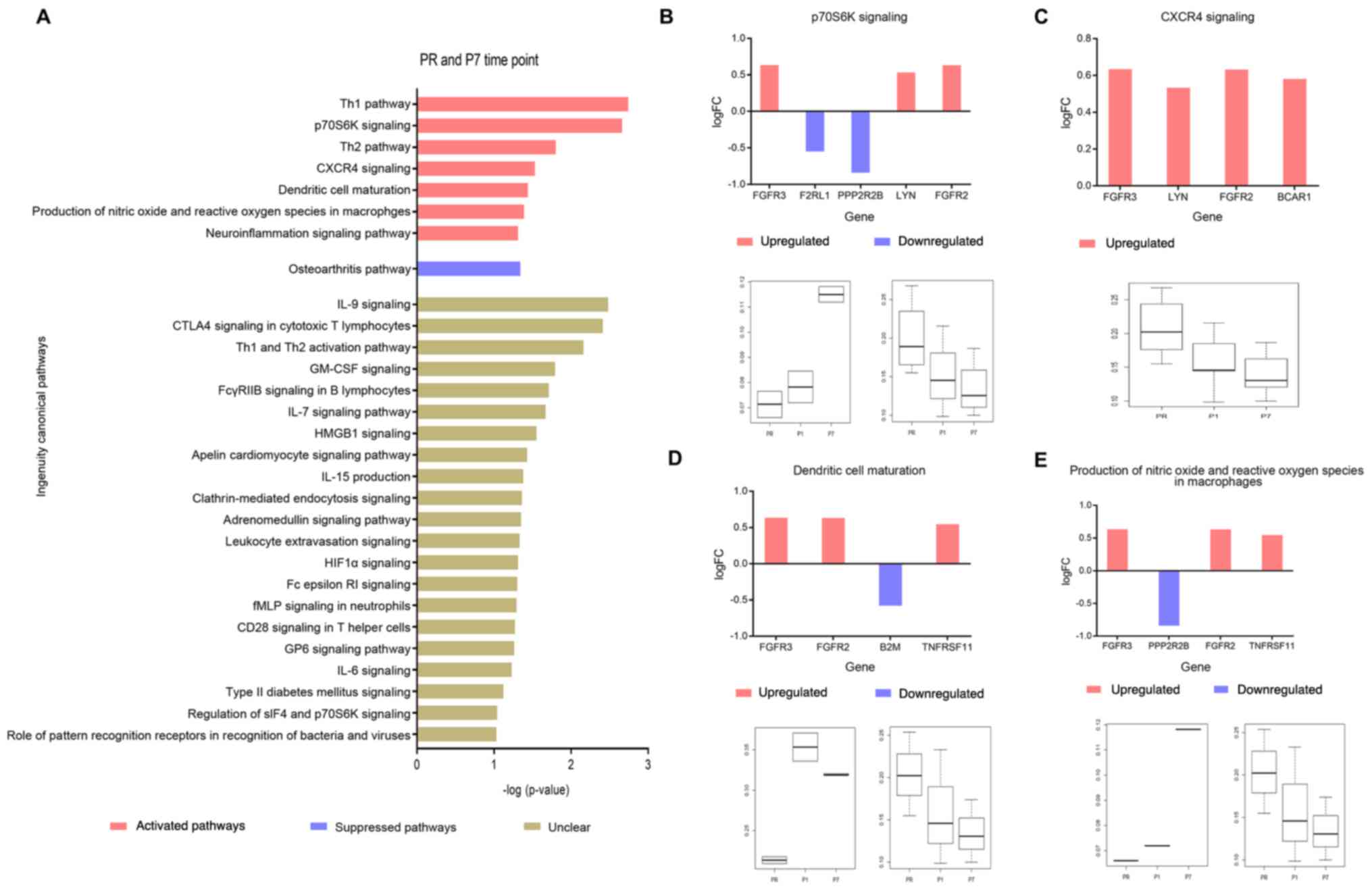|
1
|
Bray F, Ferlay J, Soerjomataram I, Siegel
RL, Torre LA and Jemal A: Global cancer statistics 2018: GLOBOCAN
estimates of incidence and mortality worldwide for 36 cancers in
185 countries. CA Cancer J Clin. 68:394–424. 2018. View Article : Google Scholar : PubMed/NCBI
|
|
2
|
Feng RM, Zong YN, Cao SM and Xu RH:
Current cancer situation in China: Good or bad news from the 2018
Global cancer statistics? Cancer Commun (Lond). 39:222019.
View Article : Google Scholar : PubMed/NCBI
|
|
3
|
Liu J, Liang W, Jing W and Liu M:
Countdown to 2030: Eliminating hepatitis B disease. China. Bull
World Health Organ. 97:230–238. 2019. View Article : Google Scholar : PubMed/NCBI
|
|
4
|
Chen MS, Li JQ, Zheng Y, Guo RP, Liang HH,
Zhang YQ, Lin XJ and Lau WY: A prospective randomized trial
comparing percutaneous local ablative therapy and partial
hepatectomy for small hepatocellular carcinoma. Ann Surg.
243:321–328. 2006. View Article : Google Scholar : PubMed/NCBI
|
|
5
|
Jiang Y, Zhou S, Shen G, Jiang H and Zhang
J: Microwave ablation combined with transcatheter arterial
chemoembolization is effective for treating unresectable
hepatoblastoma in infants and children. Medicine (Baltimore).
97:e126072018. View Article : Google Scholar : PubMed/NCBI
|
|
6
|
Tang C, Shen J, Feng W, Bao Y, Dong X, Dai
Y, Zheng Y and Zhang J: Combination therapy of radiofrequency
ablation and transarterial chemoembolization for unresectable
hepatocellular carcinoma: A retrospective study. Medicine
(Baltimore). 95:e37542016. View Article : Google Scholar : PubMed/NCBI
|
|
7
|
Wang WD, Zhang LH, Ni JY, Jiang XY, Chen
D, Chen YT, Sun HL, Luo JH and Xu LF: Radiofrequency ablation
combined with transcatheter arterial chemoembolization therapy
versus surgical resection for hepatocellular carcinoma within the
milan criteria: A meta-analysis. Korean J Radiol. 19:613–622. 2018.
View Article : Google Scholar : PubMed/NCBI
|
|
8
|
Hocquelet A, Balageas P, Laurent C, Blanc
JF, Frulio N, Salut C, Cassinotto C, Saric J, Possenti L, Bernard
PH, et al: Radiofrequency ablation versus surgical resection for
hepatocellular carcinoma within the milan criteria: A study of 281
Western patients. Int J Hyperthermia. 31:749–757. 2015. View Article : Google Scholar : PubMed/NCBI
|
|
9
|
Greten TF, Manns MP and Korangy F:
Immunotherapy of hepatocellular carcinoma. J Hepatol. 45:868–878.
2006. View Article : Google Scholar : PubMed/NCBI
|
|
10
|
Mizukoshi E, Yamashita T, Arai K,
Sunagozaka H, Ueda T, Arihara F, Kagaya T, Yamashita T, Fushimi K
and Kaneko S: Enhancement of tumor-associated antigen-specific T
cell responses by radiofrequency ablation of hepatocellular
carcinoma. Hepatology. 57:1448–1457. 2013. View Article : Google Scholar : PubMed/NCBI
|
|
11
|
Zerbini A, Pilli M, Penna A, Pelosi G,
Schianchi C, Molinari A, Schivazappa S, Zibera C, Fagnoni FF,
Ferrari C and Missale G: Radiofrequency thermal ablation of
hepatocellular carcinoma liver nodules can activate and enhance
tumor-specific T-cell responses. Cancer Res. 66:1139–1146. 2006.
View Article : Google Scholar : PubMed/NCBI
|
|
12
|
Waitz R and Solomon SB: Can local
radiofrequency ablation of tumors generate systemic immunity
against metastatic disease. Radiology. 251:1–2. 2009. View Article : Google Scholar : PubMed/NCBI
|
|
13
|
Youngblood B, Hale JS, Kissick HT, Ahn E,
Xu X, Wieland A, Araki K, West EE, Ghoneim HE, Fan Y, et al:
Effector CD8 T cells dedifferentiate into long-lived memory cells.
Nature. 552:404–409. 2017. View Article : Google Scholar : PubMed/NCBI
|
|
14
|
Schietinger A, Philip M, Krisnawan VE,
Chiu EY, Delrow JJ, Basom RS, Lauer P, Brockstedt DG, Knoblaugh SE,
Hämmerling GJ, et al: Tumor-specific T cell dysfunction is a
dynamic antigen-driven differentiation program initiated early
during tumorigenesis. Immunity. 45:389–401. 2016. View Article : Google Scholar : PubMed/NCBI
|
|
15
|
Gao W, Kondo Y, Shen L, Shimizu Y, Sano T,
Yamao K, Natsume A, Goto Y, Ito M, Murakami H, et al: Variable DNA
methylation patterns associated with progression of disease in
hepatocellular carcinomas. Carcinogenesis. 29:1901–1910. 2008.
View Article : Google Scholar : PubMed/NCBI
|
|
16
|
Ye C, Tao R, Cao Q, Zhu D, Wang Y, Wang J,
Lu J, Chen E and Li L: Whole-genome DNA methylation and
hydroxymethylation profiling for HBV-related hepatocellular
carcinoma. Int J Oncol. 49:589–602. 2016. View Article : Google Scholar : PubMed/NCBI
|
|
17
|
Ahn E, Youngblood B, Lee J, Lee J, Sarkar
S and Ahmed R: Demethylation of the PD-1 promoter is imprinted
during the effector phase of Cd8 T cell exhaustion. J Virol.
90:8934–8946. 2016. View Article : Google Scholar : PubMed/NCBI
|
|
18
|
Ghoneim HE, Fan Y, Moustaki A, Abdelsamed
HA, Dash P, Dogra P, Carter R, Awad W, Neale G, Thomas PG and
Youngblood B: De novo epigenetic programs inhibit PD-1
blockade-mediated t cell rejuvenation. Cell. 170:142–157 e19. 2017.
View Article : Google Scholar : PubMed/NCBI
|
|
19
|
Zhang Y, Petropoulos S, Liu J, Cheishvili
D, Zhou R, Dymov S, Li K, Li N and Szyf M: The signature of liver
cancer in immune cells DNA methylation. Clin Epigenetics. 10:82018.
View Article : Google Scholar : PubMed/NCBI
|
|
20
|
European Association for the Study of the
Liver. Electronic address; easloffice@easloffice.eu: Corrigendum to
‘EASL clinical practice guidelines: Management of hepatocellular
carcinoma’. J Hepatol 69 (2018) 182–236. J Hepatol.
70:8172019.PubMed/NCBI
|
|
21
|
Forner A, Reig M and Bruix J:
Hepatocellular carcinoma. Lancet. 391:1301–1314. 2018. View Article : Google Scholar : PubMed/NCBI
|
|
22
|
Morris TJ, Butcher LM, Feber A,
Teschendorff AE, Chakravarthy AR, Wojdacz TK and Beck S: ChAMP: 450
k Chip analysis methylation pipeline. Bioinformatics. 30:428–430.
2014. View Article : Google Scholar : PubMed/NCBI
|
|
23
|
Ritchie ME, Phipson B, Wu D, Hu Y, Law CW,
Shi W and Smyth GK: Limma powers differential expression analyses
for RNA-sequencing and microarray studies. Nucleic Acids Res.
43:e472015. View Article : Google Scholar : PubMed/NCBI
|
|
24
|
Aryee MJ, Jaffe AE, Corrada-Bravo H,
Ladd-Acosta C, Feinberg AP, Hansen KD and Irizarry RA: Minfi: A
flexible and comprehensive bioconductor package for the analysis of
infinium DNA methylation microarrays. Bioinformatics. 30:1363–1369.
2014. View Article : Google Scholar : PubMed/NCBI
|
|
25
|
Maksimovic J, Phipson B and Oshlack A: A
cross-package bioconductor workflow for analysing methylation array
data. Version 3. F1000Res. 5:12812016. View Article : Google Scholar : PubMed/NCBI
|
|
26
|
Leek JT, Johnson WE, Parker HS, Jaffe AE
and Storey JD: The sva package for removing batch effects and other
unwanted variation in high-throughput experiments. Bioinformatics.
28:882–883. 2012. View Article : Google Scholar : PubMed/NCBI
|
|
27
|
Jenne CN and Kubes P: Immune surveillance
by the liver. Nat Immunol. 14:996–1006. 2013. View Article : Google Scholar : PubMed/NCBI
|
|
28
|
Sun K, Jiang P, Chan KC, Wong J, Cheng YK,
Liang RH, Chan WK, Ma ES, Chan SL, Cheng SH, et al: Plasma DNA
tissue mapping by genome-wide methylation sequencing for
noninvasive prenatal, cancer, and transplantation assessments. Proc
Natl Acad Sci USA. 112:E5503–E5512. 2015. View Article : Google Scholar : PubMed/NCBI
|
|
29
|
Xu RH, Wei W, Krawczyk M, Wang W, Luo H,
Flagg K, Yi S, Shi W, Quan Q, Li K, et al: Circulating tumour DNA
methylation markers for diagnosis and prognosis of hepatocellular
carcinoma. Nat Mater. 16:1155–1161. 2017. View Article : Google Scholar : PubMed/NCBI
|
|
30
|
Molfino A, Gioia G, Rossi Fanelli F and
Laviano A: Contribution of neuroinflammation to the pathogenesis of
cancer cachexia. Mediators Inflamm. 2015:8016852015. View Article : Google Scholar : PubMed/NCBI
|
|
31
|
Haywood L, McWilliams DF, Pearson CI, Gill
SE, Ganesan A, Wilson D and Walsh DA: Inflammation and angiogenesis
in osteoarthritis. Arthritis Rheum. 48:2173–2177. 2003. View Article : Google Scholar : PubMed/NCBI
|
|
32
|
Mossanen JC and Tacke F: Role of
lymphocytes in liver cancer. Oncoimmunology. 2:e264682013.
View Article : Google Scholar : PubMed/NCBI
|
|
33
|
Fridman WH, Pages F, Sautes-Fridman C and
Galon J: The immune contexture in human tumours: Impact on clinical
outcome. Nat Rev Cancer. 12:298–306. 2012. View Article : Google Scholar : PubMed/NCBI
|
|
34
|
Lee HL, Jang JW, Lee SW, Yoo SH, Kwon JH,
Nam SW, Bae SH, Choi JY, Han NI and Yoon SK: Inflammatory cytokines
and change of Th1/Th2 balance as prognostic indicators for
hepatocellular carcinoma in patients treated with transarterial
chemoembolization. Sci Rep. 9:32602019. View Article : Google Scholar : PubMed/NCBI
|
|
35
|
Cao X: Immunology in China: The past
persent and future. Nat Immunol. 9:339–342. 2008. View Article : Google Scholar : PubMed/NCBI
|
|
36
|
O'Brien TF and Zhong XP: The role and
regulation of mTOR in T-lymphocyte function. Arch Immunol Ther Exp
(Warsz). 60:173–181. 2012. View Article : Google Scholar : PubMed/NCBI
|
|
37
|
Chatterjee S, Behnam Azad B and Nimmagadda
S: The intricate role of CXCR4 in cancer. Adv Cancer Res.
124:31–82. 2014. View Article : Google Scholar : PubMed/NCBI
|
|
38
|
Eckert F, Schilbach K, Klumpp L, Bardoscia
L, Sezgin EC, Schwab M, Zips D and Huber SM: Potential role of
CXCR4 targeting in the context of radiotherapy and immunotherapy of
cancer. Front Immunol. 9:30182018. View Article : Google Scholar : PubMed/NCBI
|
|
39
|
Guerra AD, Yeung OWH, Qi X, Kao WJ and Man
K: The anti-tumor effects of M1 macrophage-loaded poly (ethylene
glycol) and gelatin-based hydrogels on hepatocellular carcinoma.
Theranostics. 7:3732–3744. 2017. View Article : Google Scholar : PubMed/NCBI
|
|
40
|
Aras S and Zaidi MR: TAMeless traitors:
Macrophages in cancer progression and metastasis. Br J Cancer.
117:1583–1591. 2017. View Article : Google Scholar : PubMed/NCBI
|
|
41
|
Dong S, Kong J, Kong F, Kong J, Gao J, Ke
S, Wang S, Ding X, Sun W and Zheng L: Insufficient radiofrequency
ablation promotes epithelial-mesenchymal transition of
hepatocellular carcinoma cells through Akt and ERK signaling
pathways. J Transl Med. 11:2732013. View Article : Google Scholar : PubMed/NCBI
|
|
42
|
Yuan CW, Wang ZC, Liu K and Liu DJ:
Incomplete radiofrequency ablation promotes the development of
CD133+ cancer stem cells in hepatocellular carcinoma
cell line HepG2 via inducing SOX9 expression. Hepatobiliary
Pancreat Dis Int. 17:416–422. 2018. View Article : Google Scholar : PubMed/NCBI
|
|
43
|
Zhang N, Ma D, Wang L, Zhu X, Pan Q, Zhao
Y, Zhu W, Zhou J, Wang L, Chai Z, et al: Insufficient
radiofrequency ablation treated hepatocellular carcinoma cells
promote metastasis by up-regulation ITGB3. J Cancer. 8:3742–3754.
2017. View Article : Google Scholar : PubMed/NCBI
|
|
44
|
Attwood JT, Yung RL and Richardson BC: DNA
methylation and the regulation of gene transcription. Cell Mol Life
Sci. 59:241–257. 2002. View Article : Google Scholar : PubMed/NCBI
|
|
45
|
Zeng H, Zhang W, Gong Y and Xie C:
Radiotherapy activates autophagy to increase CD8+ T cell
infiltration by modulating major histocompatibility complex class-I
expression in non-small cell lung cancer. J Int Med Res.
47:3818–3830. 2019. View Article : Google Scholar : PubMed/NCBI
|

















